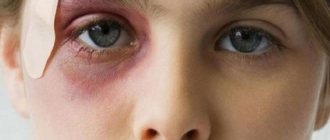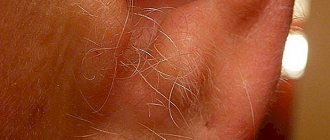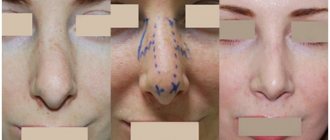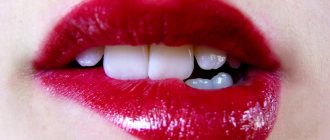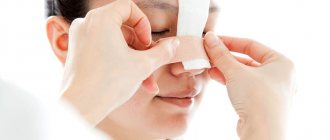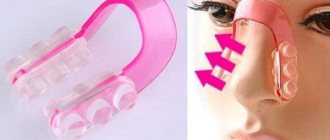How to get rid of pain after the procedure
Most infections occur due to dirty hands.
Therefore, it is important to wash your hands with soap and water before touching your piercing. The wound should be washed with soap and water
If swelling and pain are observed, you should take Ibuprofen. But if bleeding occurs, then this drug should not be taken, as it will increase the bleeding. It is better to take Paracetamol together.
Aspirin should not be used because NSAIDs prevent platelet aggregation and prevent blood clotting. Once the bleeding stage has passed, the best remedy is Ibuprofen. If necessary, as soon as the swelling goes down, replace the earring with a smaller one.
Decoration selection
It is better to choose titanium as the first metal for jewelry and only as a last resort look at surgical steel, but remember that all this does not make any sense if the jewelry is not of high quality or is completely fake. This is why buy jewelry only in trusted places.
There are two main septum decorations that greatly influence your style.
- Microbanana
- Circular
Remember that after complete healing, subcutaneous fat may be released and absorbed into poor-quality jewelry, which will cause an unpleasant odor in the nose, which can only be gotten rid of by replacing the jewelry with a new one and sterilizing the old one if you still like it.
Microbanana
It is well suited for everyone, but especially for those who do not know how friends, colleagues and family will react to piercing. Not only will this decoration be almost invisible, but it can also be easily hidden by simply wrapping it inside
There is one minus and it is that if the puncture is not made exactly, then we will not be able to notice it and therefore we will not be able to use other jewelry in the future
Circular
You can wind different balls on a circular, just like on a micro banana. It can also be hidden in the nose, and the only difference is that it is not recommended to hide it immediately after the piercing. Since the wound has not healed and it is easy to injure yourself.
What complications are possible (7 troubles)?
When performing a nose piercing, the integrity of the skin is compromised, which increases the risk of unwanted manifestations.
Problems also arise due to non-compliance with the piercing technique. But for the most part, this happens if the master does not have the necessary qualifications or if the patient has low blood clotting.
Complications after piercing appear:
- severe bleeding of the wound;
- the occurrence of inflammation in the cartilage, which can lead to its disintegration;
- injury to the nasal septum due to difficult piercing;
- inflammation in tissues;
- transformation of otitis into a chronic form;
- the formation of damage to the nasal mucosa when fixing straight nostrils;
- causing damage to the nerve in the puncture area.
Steps
Part 1
Imagine what you want your piercing to look like.
There are different types of nose piercings. Choose which one you want to make. If you are doing your first piercing yourself, it is better to choose the option with a ring or a regular stud. Imagine what you will look like with this piercing so you don't have any regrets later.
Buy some jewelry. You can choose a stud, ring or barbell. Look for something suitable in jewelry stores, tattoo parlors or gift shops. If you know exactly what you want, then look on the Internet
It is important to choose the correct size, length and thickness of the product. To begin with, it is better to choose a ring or earring of a small size.
The decoration must be new and sterile. It is not permissible to insert previously used decorations.
The skin on your nose should be clean.
If you get a piercing near an inflammation, you may get an infection at the piercing site. So if you have a rash of one kind or another on your nose, wait a few days or weeks until it goes away. During this time, wash your face using a special pore cleanser or scrub.
Prepare your needle.
The needle must be new and in complete packaging. You must be sure that no one has used it before you. It is most effective to use a small diameter hollow needle: 20G (0.9 mm) or 18G (1.0 mm). The diameter of the hole in the nose should correspond to the diameter of the jewelry you choose. After making all the preparations, remove the needle from the package. Make sure it is sterile before you pierce your skin.
- In principle, the piercing can be done with a safety pin, pushpin, earring or sewing needle. But keep in mind that you yourself may not sterilize the selected instrument well enough. Accordingly, the risk of infection is much higher. If the tool is not sharp enough, you can damage the tissue, and the process itself will be much more difficult and painful.
- Once you take the needle out of the package, do not put it anywhere. If you must put it down, use a clean cloth or sterilized container.
Pierce your nose.
While looking in the mirror, place the needle against the mark you drew. Take a deep breath and quickly pierce your nose. You will feel pain for a moment, but it will not last long. The needle must be inserted perpendicular to the surface of the skin so that it slips through the tissue of the nose.
Remember that the faster you pierce, the faster it will all be over. It is important not to push the needle too far into the nostril. If you are piercing the side of the nostril, then try not to insert the needle too deep - this is very unpleasant and painful. Immediately insert the ring or “stud” as quickly as possible. The hole you made will begin to close as soon as you remove the needle, as the wound will already be healing.
In order for the jewelry to fit perfectly in the hole, the wound must heal around it. If you delay with this, the piercing will be ruined!
Immediately insert the ring or stud as quickly as possible.
The hole you make will begin to close as soon as you remove the needle, as the wound will already be healing. In order for the jewelry to fit perfectly in the hole, the wound must heal around it. If you delay with this, the piercing will be ruined!
Part 3
Piercing Care
Treat your piercing twice a day.
You can use sterile saline, hydrogen peroxide, or mix water and soap in a 1:1 ratio. Treat the puncture site twice a day. To do this, soak a cotton swab or cotton swab in the solution and apply it to the piercing for a few minutes. The puncture needs to be treated outside and inside the nose. If you inserted a ring into your nose, then twist it slightly when doing the treatment.
Be careful not to get infected!
Clean your piercing regularly. Be sure to wash your hands before piercing and do this before each treatment. If you sterilize all the tools you use before getting the piercing and carefully clean the piercing site, you have nothing to worry about. However, if after a week the puncture site is still red and painful, then you may still have an infection. In this case, consult a doctor immediately.
It may be worth treating the wound with antibacterial soap and ointment like Neomycin to prevent infection. This will help avoid inflammation. Do not forget that if you do not regularly treat your piercing, you will likely have to take strong antibiotics that are expensive and of little benefit to the body.
Such a tempting piercing and the complications that you can encounter after it
The procedure for piercing the navel, tongue, nipples or nose is considered quite unsafe, because doctors too often have to deal with complications after piercing. To avoid such a development of events, you should familiarize yourself in advance with both the likely consequences and the reasons for their development.
Causes of complications
The main reason for unforeseen situations during the procedure is the penetration of an infectious agent into the wound surface. And if infection occurs, it is accompanied by symptoms indicating intoxication of the body.
Complications often arise in those people who decided to save money and got a puncture done at home or by a specialist without the appropriate permits.
Sterility during piercing can only be maintained in a clinic or stationary beauty salon.
In addition, the master must use only disposable tools and have documents confirming that he does not have dangerous infectious diseases.
An unsuccessful puncture can lead to damage to blood vessels and nerves - another reason for the development of complications. For example, when an eyebrow is pierced, damage to the facial nerves can occur, which, if left untreated, can lead to their paralysis.
Often, the clients of beauty salons themselves are to blame for the fact that a complication has developed after a piercing. They do not adhere to the rules of conduct during the recovery period.
We recommend reading about tongue piercing. You will learn about the types of punctures, jewelry, the pros and cons of a hole in this area, the procedure for performing the procedure, and possible consequences. And here is more information about how the navel is pierced and the possible consequences afterwards.
Real negative consequences after piercing
If you decide to decorate your body with an earring, you should familiarize yourself in advance with possible complications after the procedure.
Language
When the tongue is pierced, the following unpleasant consequences are most often noted:
- problems chewing solid foods;
- damage to tooth enamel;
- speech disorder;
- sleep disturbance (insomnia).
To see what complications may arise after a tongue piercing, watch this video:
Eyebrow
If the piercing is done on the eyebrows, then damage to the eye or facial nerve is possible. In the first case, there is a high probability of deterioration in visual acuity, in the second - the development of facial nerve paralysis. Often, eyebrow piercing is accompanied by the formation of an extensive hematoma.
Complications after eyebrow, ear and tongue piercings
Private parts of the body
Quite often, nipples and certain places in the intimate area are pierced. This procedure is often accompanied by the development of inflammation at the puncture site. In the future, problems with sexual life may arise: the sensitivity of the nipples decreases, jewelry in the clitoris or foreskin causes pain during sexual intercourse and makes it impossible to use a condom as a contraceptive.
Lips, cheeks
If the jewelry is installed in the lip, then it is almost impossible to avoid infection of the wound: fragments of food and various liquids, sweat and dust, saliva constantly get into the wound. The same complication is often noted when the cheek is pierced.
Nose
Nose piercing is considered the simplest and safest procedure of all. But even such a puncture can be complicated by infection of the wound surface and a progressive inflammatory process.
Coccyx
Piercings on the tailbone are rarely done, but if such a piercing already exists, then you should be wary of infection of the wound, loss of sensitivity in this area and damage to nerve endings.
Are common
Regardless of where the piercing is done, infection with AIDS, herpetic virus, and hepatitis can occur. In addition, with an incorrectly made puncture or ill-chosen jewelry, a patch of connective tissue can form. In this case, the jewelry will have to be removed, and a keloid scar will form at the piercing site.
The first signs of complications after piercing:
- redness at the puncture site;
- pain, itching and feeling of heat;
- increase in general body temperature;
- purulent discharge from under the jewelry.
The appearance of these symptoms is a reason to visit a doctor. If left untreated, infection and inflammation can develop into sepsis, a pathology that is characterized by rapid development and often ends in the death of a person.
About piercing, complications and their prevention, watch this video:
Methods for getting rid of piercing complications
If there are signs of inflammation at the puncture site, then some measures can be taken to stop the process:
- Wiping the puncture site with an alcohol solution.
A cotton swab soaked in any antiseptic - Chlorhexidine or Furacilin - should be applied to the puncture site twice a day. You can wash the wound with the same solutions, and then apply a gauze pad with Levomikol or Tetracycline ointment. - A day 2-3 times you need to wipe the piercing site with a cotton swab dipped in hydrogen peroxide. In this way, you can remove the crusts without damaging the skin and prevent infection of the wound.
- If a small lump appears after the wound has healed (it feels like a ball under your fingers), you need to massage it. But this procedure is allowed to be performed only after complete healing of the wound and in the absence of symptoms of inflammation. Before each kneading of the seal, you need to remove the jewelry and lubricate the puncture site with baby cream. After the procedure, the area is wiped with hydrogen peroxide.
In some cases, complications from piercing are so serious that home treatments cannot solve the problem. For example, the formation of keloid scars requires surgical treatment. Doctors can use cryodestruction, perform an operation to excise connective tissue, prescribe sessions of phonophoresis or laser therapy.
Most often, several types of medical procedures are used to eliminate complications, which increases the chances of obtaining a positive effect. Unfortunately, it is not possible to completely get rid of keloid scars; traces of their “presence” still remain.
We recommend reading about eyebrow piercing. You will learn about the types of punctures in this area, jewelry, contraindications to the procedure, methods of performing the procedure, and skin care after. And here is more about the unusual otoplasty - elf ears.
How to avoid complications
To avoid complications after puncture and installation of jewelry, you should follow the following rules:
- Perform the procedure only in specialized clinics or offices, having familiarized yourself with the working conditions of the master and the permits for conducting such activities.
- After the puncture, do not visit baths and saunas, public swimming pools and open reservoirs for 2 - 3 months, do not take a bath, and limit yourself to a shower.
- Every day after the procedure, treat the wound with Chlorhexidine or Miramistin until it is completely healed.
- If you have your tongue pierced, you should rinse your mouth after every meal and drink.
- Do not touch or twist the jewelry until the wound is completely healed.
- Before getting a piercing, visit a therapist and undergo an examination. There are a number of contraindications to the procedure in question:
- diabetes;
- periods of pregnancy and breastfeeding;
- AIDS or HIV infection;
- viral hepatitis;
- malignant neoplasms;
- herpetic infection;
- any psycho-emotional disorders;
- epilepsy even in the absence of active seizures for a long time.
Piercing is a procedure with a high probability of complications. They can be completely avoided if you follow the rules of behavior during the recovery period and have the procedure done in specialized institutions.
Source: https://PlasticInform.com/posle-plastiki/oslozhneniya-posle-plastiki/pirsing-oslozhneniya.html
What is a piercing procedure?
Nose piercing most often means piercing the sides of the wings of the nose, and this can be either the creation of one channel or several at once. Less commonly, the puncture is performed in the nasal septum, at its tip, or in the area of the bridge of the nose between the eyebrows.
If the procedure is performed by a professional, it usually takes only a few minutes. Piercing the soft tissues of the nose is not painful and can therefore be done even at home. But if an effect on cartilage or bone structures is implied, then you cannot do without the help of a specialist.
Nose piercing is mainly done by young people and the motives for such body modification are completely different among different categories of people. Some people just want to decorate their face and make it more memorable.
For others, punctures in different parts of the body are a tribute to some religious culture or a challenge to society, a desire to impress ordinary people with their appearance. But whatever the true reasons leading to piercing, you always need to know the disadvantages of this procedure.
The feasibility of a piercing: what does a piercing in a girl’s nose mean and how to prepare for it
Always emphasize your own beauty, stand out from the gray mass, express yourself the way you want, these are the main reasons for getting a nose piercing called by modern girls and women, and guys are also not lagging behind them in the pursuit of originality and uniqueness. Today, nose piercing is at the peak of popularity, but it is not a recent invention, but has been known and successfully practiced for many centuries, for example, among Indian women, where everything, no matter what is done, matters. But even before that, on the hot shores of Africa, members of tribes and communities used such punctures to prove their masculinity.
Initially, the tradition of piercing the nose and inserting an earring into it came to America, and then to other parts of the world from India, where it was brought by hippies. Imbued with culture, they wanted in everything to be like those whose lives, views and ideals they liked so much. In fact, piercings were done by Indian girls and boys, they inserted a ring-earring into the hole to demonstrate that they were busy or married. Today, no one puts such meaning into a puncture, however, it is worth knowing such information for general education.
Interesting
Modern young people are not even interested in what a nose piercing is called before getting it done, however, there are several types of similar punctures, and each of them has its own name, which would not hurt to find out if you are planning to take such a step. In addition, you need to know that the first nose earring cannot be platinum, gold, or, especially, silver. Exclusively medical steel and nothing more.
Restrictions and contraindications
It is worth understanding that despite the apparent simplicity and accessibility of such a puncture, nose piercing can cause quite unpleasant consequences, which we will talk about a little later. In the meantime, it is worth discussing what steps need to be taken to avoid such consequences. In fact, everything is quite simple, it is worth spending time on the issue so as not to regret later, because if the puncture or subsequent care is incorrect, it is quite possible that surgical medical care will be required.
- Before deciding to undergo such a puncture, make sure that you do not have heart or cardiovascular diseases, inflammatory processes in the body, or fever.
- You should not get a nose piercing if any chronic disease is in the acute stage.
- Before the puncture, you should not take oral contraceptives or other hormonal medications for a week.
- You should consult your doctor about taking pills before and after piercing, especially those that affect blood clotting. For example, aspirin is strictly contraindicated in such cases.
- The day before the puncture, you should not drink coffee or strong tea, limit smoking, and completely give up alcohol, be it a sip of wine or a glass of beer.
How can you tell if a body piercing is inflamed?
3. A clear sign of the beginning of the process is swelling of the soft tissues, which intensifies every day and does not go away.
4. Doctors recommend that if you have the above symptoms, you should touch the area where the penis was punctured.
– if it is much hotter than other parts of the body, it means that the infection is “working” in full force in this area.
5. Developing inflammation is often indicated by the appearance of a febrile state - an increase in temperature to 38 degrees or more. Loss of appetite, lethargy, and chills may occur. These are quite dangerous symptoms that may indicate not only local inflammation, but also that the infection has flared up at full strength and has already systemically affected the entire body. Urgently see a doctor.
An unpleasant odor is a clear sign. How to recognize suppuration of a puncture
6. The next sign is an unpleasant odor from the piercing channel.
. We need to figure this out. For example, lymph oozing from a wound (the first day or two after perforation) also smells far from deodorant. However, its color is yellow, transparent, without any green or brown impurities. If a smelly greenish-yellow-brown substance is released, it is an infection.
7. A reason to worry about infection is constantly weeping crusts on and around the puncture. When pressed, purulent fluid may be released. This means that suppuration begins.
8. Multiple organ piercings
It is easy to recognize inflammation by the fact that the functions of an organ have been partially impaired or its sensitivity has decreased/completely lost.
This, for example, happens with punctures on the frenulum of the tongue
, if it “tosses and turns” heavily in the mouth, “does not distinguish” tastes - then this probably indicates an inflammatory process.
Piercing is now at the peak of newfangled trends: girls and guys are striving with all their might to stand out in some way, to take on a look that would fit their “party” and show their individuality in every possible way. Using the procedure, young people place jewelry on the body by making holes in it. And, unfortunately, he doesn’t think about the consequences.
The most common puncture sites:
- Language;
- Lips (including intimate ones);
- Brows;
- Navel;
- Other parts of the body.
When performing nose piercing, specialists use a variety of techniques. The puncture can be performed in various places.
The simplest and most common method is a single puncture of the nostril. Nasal septum piercing, located between the nostrils, is also popular.
A similar procedure is performed for lovers of such jewelry as a septum - it hangs directly above the lip. The event is dangerous because it can cause infection and other complications.
When a nose piercing should not be done: possible complications
A nose piercing will highlight this part of your face even more. Therefore, jewelry should be worn in the nose if this organ is not large in size and looks neat. Although this warning does not apply to those who not only want to decorate themselves, but want to stand out from the crowd.
But besides the aesthetic component of facial piercing, there are many more points that are worth focusing on before deciding to pierce your body.
Any piercing is a violation of the integrity of the skin, in which all layers of the skin, nerve endings and blood vessels are affected. That is, the procedure will be painful, the bleeding will vary in severity, and most importantly, it will increase the risk of infection.
After the manipulation itself, several weeks must pass for the canal under the jewelry in the nose to completely heal; during this time, special care for the injured area is required.
Common complications of nose piercing include:
- Possibility of infection. In mild cases, inflammation is limited to only the affected area, but abscesses may form in some people. The use of non-sterile instruments is dangerous in terms of introducing hepatitis viruses and HIV infection.
- Prolonged bleeding. The risk of prolonged bleeding increases with problems with the circulatory system and with certain diseases.
- The formation of keloids, that is, rough scars. Such a complication is considered an individual reaction of the body; it is quite difficult to predict it. You can assume the appearance of rough scars if they already exist in other parts of the body after injury.
- Entry of a foreign body, that is, jewelry, into the respiratory tract.
In specialized salons, where there is a license, and the procedure itself is carried out by specially trained specialists, they always find out whether there are contraindications for piercing. Nose piercing is not performed if:
- There are blood diseases that interfere with blood clotting.
- There are severe diseases of the heart, liver, and kidneys.
- An acute infectious or inflammatory disease occurs.
- Allergic reactions to metals have been identified.
- There are dermatological diseases.
It is not recommended to do piercing during pregnancy, people with cancer, or during menstruation. If you have an increased threshold for pain sensitivity, you need to take into account that piercing the nose in some places can be very painful.
It should also be taken into account that cartilage and bones grow up to 18-20 years of age, and manipulation before this period can lead to unnecessary external changes in the shape of the nose in the future.
Does it hurt to get your nose pierced?
Any violation of the skin is accompanied by pain. Even a small abrasion brings discomfort. Therefore, it is obvious that piercing the nasal cartilage is not a painless procedure. However, the degree of pain can be reduced if you use only modern equipment and trust the hands of a professional.
Many people, for example, are interested in how to pierce your nose with a gun? In fact, this is the fastest and most painless procedure. After all, a puncture takes a fraction of a second. In addition, it has been proven that only when using a gun does the skin heal faster.
Meaning - which side is the piercing on?
Sometimes on women's forums you can find arguments that piercings on different sides of the face have a hidden sacred meaning. In fact, these are all stereotypes. The choice of which side of the nose to pierce is purely individual and depends only on the beauty of the chosen half of the face.
Some girls prefer a parting on the left side, others - on the right. Same with punctures. To finally decide, you can try on a fake or magnetic piercing. Due to the fact that such a false piercing looks very natural, it will be an excellent experiment for your appearance if you want to pierce your skin, but are afraid.
Piercing on both sides of the nose
The photo of the nose piercing clearly shows that it looks great on both the right and left sides of the face. Moreover, it does not vulgarize the image one bit, but only emphasizes the sophistication of the appearance.
Will there be a hole in the nose after piercing?
When wearing jewelry for a long time, a channel is formed and after removing the earring, it can last for many years.
If your living conditions require you to abandon the piercing, but you have had it for more than a year, you can safely remove the jewelry for the required period of time and then install it back. These actions will not cause tissue trauma and will not lead to undesirable consequences.
If the piercing is fresh and there is a need to constantly remove the jewelry, then it is better to refuse the piercing and allow the wound to heal. Since by constantly removing jewelry you will injure yourself and increase the likelihood of infection.
What are the consequences of piercing?
Possible consequences of piercing can be classified into two groups.
Skin problems
An allergy to metal is often discovered only after the piercing has been performed. Symptoms: prolonged healing of the wound, formation of pus, swelling around, etc. If you do not understand the cause in time and do not remove the jewelry, a serious inflammatory process may begin.
Another problem with piercing is the proliferation of connective tissue and the formation of keloid scars. This can happen due to improper care of the wound or due to the unprofessionalism of the master (for example, if too much or little skin was captured during the puncture).
Earrings and jewelry for nose piercing
Earrings are divided not only by shape, but also by purpose and the material from which they are made. The following materials are used to make piercing earrings:
Medical steel. Previously, all salons that provided ear, eyebrow and nose piercing services worked only with such jewelry
But it is important to know one thing - the term “medical steel” does not exist at all. This is the name for the combination of steel and titanium
It does not in any way affect the healing rate of the puncture, but is not susceptible to corrosion; Plastic. It looks very unusual and is almost invisible in holes due to its light weight. Enjoys special love among informal girls. It is easy to care for and resistant to external negative factors. In addition, it does not freeze in cold weather; Gold nose piercing is the most expensive, but the safest. The main advantages of this noble metal are that it promotes regeneration and is extremely rarely rejected by the body; Silver. Cheaper than gold, but no less popular precious metal. Suitable for almost everyone. May cause allergies only in exceptional cases.
Nose earrings and other jewelry that are installed at the piercing site must meet certain requirements
This is important because they interact with the wound on the skin and are designed to remain permanently in the soft tissue or nasal cartilage
Among them:
- possibility of sterilization;
- hypoallergenic material;
- simple removal mechanism;
- ease of care;
- comfortable to wear;
- aesthetic appearance.
Types of decorations
Piercing jewelry varies in shape and material. We can highlight:
- classic rings, often used for the wings of the nose or septum - nose piercing like a bull;
- nostrillas for the wings of the nose;
- half rings for septum;
- tunnels for the wings of the nose (circular piercing) and combined piercing of the wings and septum;
- labret and microlabret for the wing of the nose, reminiscent of carnations;
- bananas and barbells, circulars for all types of piercings.
We suggest you familiarize yourself with How to remove age spots on the face: 3 methods, 7 cosmetics and 6 folk recipes
For installation for the first time, it is recommended to purchase jewelry made of titanium, medical steel or bioplastic.
types of nose earrings
After the piercing channel has healed and formed, you can use a gold piercing, as well as:
- silver;
- tree;
- platinum;
- bone.
Jewelry piercings can be decorated with precious or semi-precious stones (for example, diamond piercings).
ring and earrings with stones
Imitation of piercing
If you don’t like punctures of soft tissue or cartilage of the nose, but still want to add some zest to your look, then you can use a fake piercing. To attach this decoration:
- on the clamp;
- on a magnet;
- on a suction cup;
- on glue;
the silver earring must have a hallmark
Place of puncture
Today, there are mainly three types of punctures. Nose wing piercing is the most popular type, especially among young people. It has been known for a long time, coming from South Asia. In India and Nepal, the wings of a woman's nose have reproductive symbolism, so it is very common to have her nose pierced before marriage. The second type of piercing is a puncture of the cartilaginous internostril septum (septum), and the third, most painful type, is a piercing of the bridge of the nose. In each case, the puncture is made with a needle, and the pain sensation depends on your pain threshold. That is, for one person it will be a completely ordinary procedure, but for another it will be really painful.
In addition, do not forget about the healing period of the puncture, during which many people feel discomfort. This also depends on the characteristics of each person, but usually the bridge of the nose takes the longest to heal - 6-10 weeks, the nasal septum - 6-8 weeks, the wings of the nose - 4-6 weeks. With proper care, particularly painful sensations can be avoided, but you should strictly follow the instructions of professionals, and the puncture itself should only be done by specialists.
Since professional nose piercing is expensive, you may decide to do it yourself at home. To do this, it is enough to find out how the piercing is done and follow the rules of hygiene. If you are not afraid of pain and are willing to take risks, then try piercing your nose yourself. However, keep in mind that a professional will most likely do it faster, better and without unwanted consequences.
Caring for a puncture and possible consequences
The recovery period for a perforation site depends on its type and complexity. The fastest way to restore a wound is on the wing of the nose, which takes about 4 weeks. Other types need a longer time - from 6 to 8 months
But it is important to know how to properly care for a puncture and what to treat
The rules for caring for perforation are as follows:
- Do not touch the puncture site with dirty hands to avoid infection.
- Treat the wound with a cotton pad soaked in saline solution. Apply compresses until the crust disappears.
- Doctors advise putting drops containing sea water into your nose. Great options are Aqualor or Otrivin.
- Carefully blot the perforation area with napkins, as the towel may catch on the earring.
- To speed up healing, lubricate the punctured area with lavender oil.
- It is forbidden to peel off the crust, otherwise you may get an infection. This will cause complications.
- The earring can be removed only after the wound has completely healed.
- Cosmetics should not be applied to the piercing site.
In the first six months, it is not recommended to remove the earring for more than a day to prevent the puncture from tightening. The hole is tightened depending on the characteristics of the body. Hook piercings should be worn as late as possible to allow the wound time to fully heal and form.
If you do not follow simple rules, a nose piercing can cause complications. They can also occur if the puncture technique is not followed. The most common are:
- nerve damage;
- the appearance of permanent otitis media;
- severe bleeding;
- acute inflammatory process in cartilage;
- damage to the nasal septum;
- inflammation of soft tissues;
- damage to the mucous membrane by direct nostrilla.
If we consider the question of whether it is painful to pierce the nose, then it all depends on the human body. Much depends on the pain threshold, the skill of the nose piercer, instruments, pain relief and, of course, psychological attitude. Many people claim that a nose piercing is no more painful than an ear piercing.
But to avoid complications and suppuration, it is important to follow the rules of hygiene.
Today, no one is surprised by a nose piercing.
- The second most popular piercing after ear piercing. Piercing is one of the ways of self-expression. There are several options for nose piercing:
Nasal septum piercing. Does it hurt to get your nose pierced? In this case, definitely yes. The pain does not last long, only at the moment of piercing, but the pain is quite strong. The reason for this is the location of many receptors in a given area.
- Nostril piercing
involves wearing an earring that resembles a barbell, with a pebble at one end and a hook at the other. Piercing your nose in this case is not as painful as in the previous one. Narrowing of the nasal passages is a contraindication to this type of piercing. - Piercing the bridge of the nose
is the most difficult and even dangerous, which is why it is not particularly popular among young people.
Symptoms and signs of adverse effects
The most common complication that can result from nose piercing is the possibility of infection in the puncture, causing the development of inflammation.
The person then develops rough scars on the skin. Such a negative phenomenon is the result of unqualified performance of a cosmetic procedure.
A common unpleasant consequence of poor-quality piercing is the formation of keloid scars located around the puncture site.
They are clearly visible and may be accompanied by itching, tingling, burning or certain pain sensations.
To prevent scarring, it is advisable to visit a dermatologist before the nose piercing procedure. It will determine how prone your skin is to the appearance of such formations.
Another unpleasant symptom that occurs after a cosmetic procedure can be redness and swelling around the puncture site. Although, immediately after it, such a reaction to external intervention on the skin is logical.
Caring for your piercing involves salt baths, but when the swelling does not go away for a long time, it means there is a possibility of infection.
In such a situation, you cannot treat the puncture with alcohol or hydrogen peroxide - this can only cause even more severe inflammation.
You need to see a doctor immediately
, he will prescribe you a special remedy that relieves inflammation.
Nose piercing is dangerous for people suffering from chronic or congenital heart and kidney diseases.
It is also preferable to refuse the procedure if there are skin diseases, epileptic seizures, or asthmatic attacks.
People who are allergic to metals should be especially careful when performing punctures.
This type of allergy is the main problem for people who want to get a nose piercing. The wound may not heal for quite a long time; it constantly swells and festeres (by the way, smoking and drinking alcohol also do not contribute to rapid healing).
Let's summarize. The risks of getting a nose piercing are:
- Possibility of pigmentation of the skin, constant, long-lasting inflammation, the appearance of scars and chronic keloids;
- There is a possibility of infection with hepatitis, AIDS, and other blood diseases.
Price
What is the pricing for nose piercing services in the capital and cities of the Russian Federation? The cost of nasal piercing in Moscow varies between 1000-2200 rubles.
The operation is performed either with or without the simultaneous purchase of jewelry suggested by a specialist. The price also depends on the technique of the event, which is why it increases.
- In Voronezh, a nose piercing with a needle and earring will cost the patient 1,200 rubles.
- In Novosibirsk, it is possible to pierce your nose at an average price of 800 rubles.
- In Petrozavodsk it is offered to get a nose piercing for 700-1000 rubles.
- In Yekaterinburg, the most inexpensive nose piercing service costs 600-800 rubles.
The question of whether it hurts to pierce your nose is asked by every person who wants to decorate their body. The disadvantage of piercing is pain not only during the puncture, but also during the healing of the wound. But different areas on the human body and face have different degrees of innervation. An equally important role is played by the method of puncture - manually or with a pistol, as well as the use of an anesthetic.
Is it worth getting your nose pierced?
The classic nostril piercing has been popular for a long time; septril has become fashionable in the last 3-5 years. In this regard, many people ask whether it is dangerous to pierce their nose in a salon. Piercing done by professionals is safe, and complications rarely arise after it.
Whether it is worth getting your nose pierced is up to you to decide for yourself. If in this way you want to express yourself and your ideas about beauty, then, of course, yes. If thoughts about facial modification arose as a tribute to fashion, then you should abandon this idea. If such decoration of yourself is not congenial to you, you will not feel comfortable with it.
Puncture technology
Only a person who has undergone special training and has a medical record and a license to perform the work can do piercing. It would also be nice if the master had a certificate of listening to a course of lectures on blood diseases.
Typically, piercing is done without anesthesia, so that the client can report pain during and after the piercing. And they always exist, because in essence, the integrity of the skin is violated. Before the procedure, the master sterilizes instruments and jewelry, disinfects his hands and the work area. The puncture is made while the client is inhaling, an earring, ring or barbell is immediately inserted there and fixed. The danger of piercing often lies in the violation of the technology of the procedure: if the puncture is not done according to the rules, or in unsanitary conditions, a person’s health can be seriously affected.
Popular areas of the body for piercings
From an anatomical point of view, piercing can be done in any soft place. But to minimize risks, people usually choose common places.
Navel
Popular among young girls who want to highlight their flat tummy or toned abs. Having your navel pierced is very painful, and after the procedure, you must follow strict rules for 2-3 weeks: do not strain your stomach, do not bend over, do not sunbathe, do not take a hot shower. When a girl becomes pregnant, the jewelry must be removed.
Nose
Nose studs are loved by older women who really want to express themselves, but understand that a barbell in the eyebrows or a bead in the chin is too extreme. Young people belonging to informal trends often decorate the wings of the nose or the septum with a ring.
Lips
The earring is usually inserted into the lower lip - in the center or on the side. This is one of the most difficult types of piercing because you need to make sure that the jewelry does not touch the teeth.
Ears
We are not talking about the earlobe, but about the entire shell. Cartilage can also be decorated with studs, rings and custom earrings. Kate Moss, for example, has six earrings on her right ear.
Brows
Eyebrow piercing is very common among young people. The decoration for this area of the face is a barbell: an earring with beads on both ends. These beads are the piercing fixatives.
Attention! There are many blood vessels approaching the eyebrow; a puncture can cause a lot of blood, so this type of piercing is contraindicated for people with poor clotting ability.
Nipples
A girl who decides to have such a piercing puts her full motherhood at risk. Feeding a child with a pierced breast is out of the question, and not every immune system is calm about this kind of experimentation on the body. But some women take such risks in order to surprise their partner.
Language
A tongue piercing may seem invisible, but when you talk to such a person, it becomes clear that he has something in his mouth. Young boys and girls especially like to amaze others in this way.
Genitals
Piercing of intimate places is not a sight for the faint of heart. Only very brave and, one might say, fearless people do this kind of “tuning”. After all, it is not only painful, but also extremely dangerous. The purpose of intimate piercing: obtaining new sensations during sexual intercourse.
The imagination of clients and artists when performing genital piercings is limitless. Girls can pierce their clitoris or the fold of skin above it, the labia minora and majora, or the pubis. Men usually get piercings on the head of their penis.
What are the signs of inflammation of a puncture?
The opinion of doctors on this matter sounds encouraging: the sooner the owner of an intimate piercing notices signs of inflammation, the more favorable the prognosis for its elimination without such consequences as blood poisoning, excruciating pain, rejection and the formation of terrible scars. What signs can be used to determine the onset of the inflammatory process in nipple piercings?
, genitals, on the face and other areas?
1. Painful sensations have increased. If the first time after the procedure the treatment site is itchy and painful, this is normal, because an injury has occurred. However, painful sensations should not last more than 2-3 days, and especially not become acute and unbearable. And when even a light touch to the ear piercing causes sharp pain, this is a clear sign of infection.
2. Intense and persistent redness around the perforation sites also indicates inflammation. A slight pinkishness of the skin in the first days after the procedure is normal, a bright shade after a few days is already bad.

